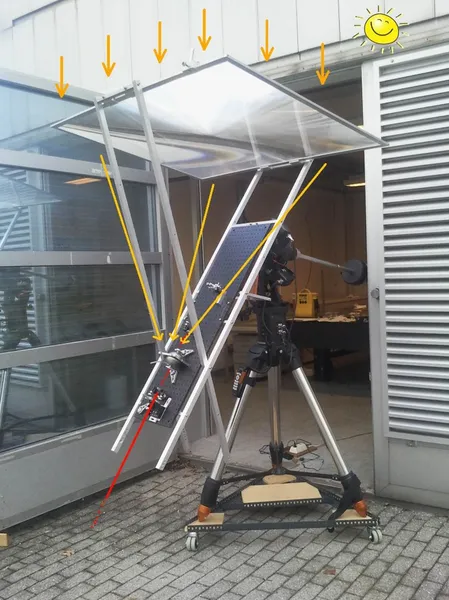Sun-Pumped Laser
A laser consists of a resonator (in the simplest case two mirrors), a laser medium and an energy source to excite the medium, the "pump". The sun-pumped laser is a directly sunlight-pumped continuous-wave solid state laser. So that a laser crystal can be pumped directly by sunlight, a suitable optical system is required. The sunlight is focused with a 1.3 m2 Fresnel lens. Then, the concentraded sunlight is coupled in a multimode fiber via a combination of lenses. To pump the laser crystal, only a small part of the solar spectrum may be used. Therefore, the spectrum has to be filtered in the lens system in two stages, in order to couple only the pump wavelength of 808 nm into the optical fiber. The first stage, a red film, is located directly on the Fresnel lens and transmits about 50% of the spectrum.
The second filter stage is located in front of the fiber. The filter can only be passed by a small range around the required pump wavelength of 808 nm. Now, the optical fiber guides the sunlight to a table on which the laser is positioned. The laser is pumped axially through the coupling mirror. Therefor, the filtered sunlight has to be precisely focused in the active medium. The laser medium is a Nd:YAG crystal. The neodymium laser is the most popular solid-state laser. Y3Al5O12 is a hard cubic crystal with good optical quality and a high thermal conductivity. For the realization of a Nd:YAG laser approximately 1% of the Y3+ ions are replaced by Nd3+ ions.
Due to these characteristics, the crystal is particularly suitable for the continuous pumping with sunlight. The main laser transition of the crystal emits radiation at a wavelength of 1064 nm. It is desirable to be able to actually see the radiation. Therefor it is required to generate the second harmonic within the resonator to get laser light at a wavelength of 532 nm, which is visible to the human eye. To get enough energy for the optical pumping of the crystal it is necessary to align the Fresnel lens to the present position of the sun. Therefor the hole optical system is mounted on a computer-controlled telescoping tripod. After the tripod is aligned properly it allows an accurate alignment and tracking towards the sun.
